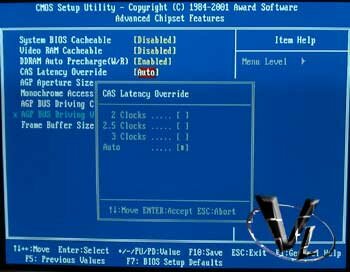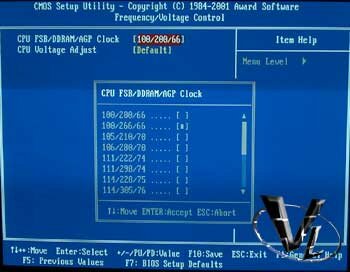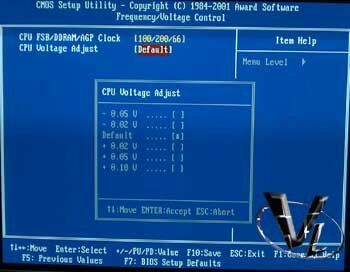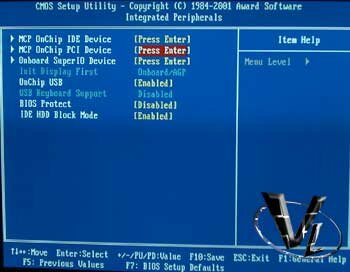|
BIOS
 
The MSI K7N420 Pro uses the popular Award BIOS. Personally, I prefer this one over the AMI, but to each there own. Having used countless motherboards with the Award BIOS, I immediately felt at home with this one. At least, so I thought...
The BIOS main screen is pretty much identical with other versions, as well some of the more common menus, such as Standard and Advanced features.
 
For overclockers, MSI accomadates you with memory timings and voltage adjustments. There's even CPU overclocking options, but on my board, I only had multiplier adjustments (!), which was actually something that bothered me, since I originally was planning on dropping in my unlocked Athlon into there and setting up a small gaming rig. I went through all the advanced options, but alas, either I'm blind, or there is no multiplier setting.
 
Moving on, you can make changes to various integrated peripherals. Your options are fairly limited, as you can only choose to enable or disable your devices. If you plan on using the included GeForce 2, the overclocking is set in Windows, so you don't have much in the way of overclocking it in the BIOS. Be aware that you will lose 32MB of system ram to the video.
Overclocking
Well, since I haven't been able to do anything in regards to the multiplier, I discarded the intended Athlon 1.4GHz, and dropped my Athlon XP 1800+ in there. I may as well mention that I've had a lot of problems unlocking my XP chip, even though I followed overclockers.com's instructions as well as I could. So, since the multiplier was locked, it'd be suitable for testing here, and we'll concentrate more fully on FSB. I went through a barrage of overclocking attempts, and this was my success story:
FSB= 157... No post
FSB= 154... Post, BIOS splash corruption (!)
FSB= 147, 145... Post, ESCD Success, Starting Windows 2000, corrupt system files
FSB= 140...Success (140/280/70)
Temperatures, when checking the BIOS, were not terribly high, so I don't really think heat was the likely culprit. Ram was set to CAS 2.5, and the vCore set to 1.85v. I did try disabling the sound (not video), and managed a post into Windows at FSB=141, but it was a bit unstable (crashes constantly), so I dismissed it. My guess, is since the multiplier was clocked so high (11.5), that probably what was causing me so much grief. Still, I've seen others with more success, but 11.5x140 is still fast (Athlon XP 1900+ speeds).
*Update* - At the time of the original testing, the multiplier settings were unavailable in the BIOS. There is a BIOS update available that allows for multiplier adjustments.
Performance
First things I'll get off my chest is that the hype regarding StreamThru wasn't so obvious to me. My Internet connection didn't seem to feel any faster, nor did it feel any less laggy. I did a file transfer from one PC to another and sometimes it was faster than my regular NIC, and sometimes it was slower, whether or not it was small or large files. This isn't a bad thing, since it meant it didn't perform any worse than my 3Com card. Anyhow, for something free (though in reality, you paid for it), it didn't bother me
too much.
The sound did impress me though. I wasn't able to test the 5.1 features, given I only have a 4.1 setup, but the sound quality didn't sound any worse than my Sound Blaster Audigy. I tried a friend's Senheiser headphones after, since admittingly, my speaker setup isn't all that impressive, and the only real difference I could pick out, while listening to my N'SYNC CD, was that the Audigy sound was deeper and perhaps clearer. It was tough to tell, but certainly, if you're building a nForce system from scratch, and if you had intended to buy a 5.1 sound card, there is no need to. Unless you're an audiophile or need a breakout box like the ones offered by Creative and Hercules, the one here will suit you fine. Hey! It's free. (See comments in last paragraph :P) Be aware that for the Dolby Digital, the southbridge will be labeled MCP-D, which this one was.
The video is essentially a 32MB GeForce 2 MX. I'm not going to go into much detail here, but it's a fully compliant Direct X 7 video GPU (At least compliant with the stuff that matters), has Transform and Lighting, and runs cool enough that only passive cooling is required. You can place a beefier heatsink and fan combo on it I suppose, but I don't really see the point. Unlike a dedicated video card, you can fry a lot more than just the GPU this time around.
Previous Page - The Board
Next Page - Benchmarks and Final Words
|
